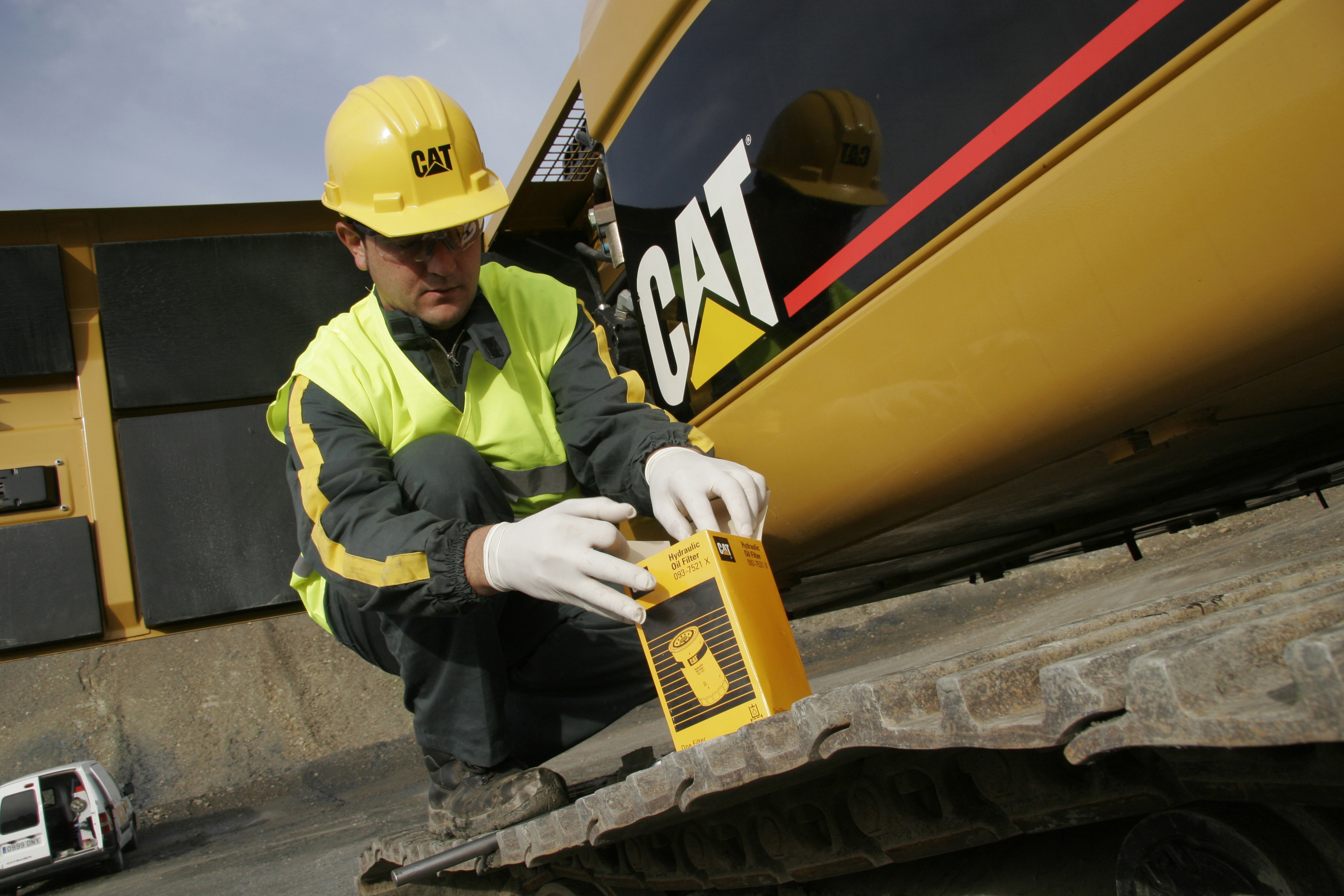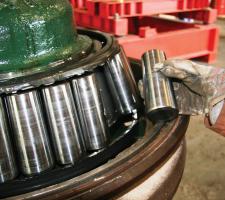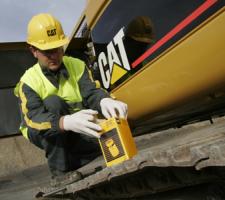
Cost-effective maintenance and efficient parts replacement have become even more important in achieving greater efficiency in challenging times. Lisa Russell reports
Budget reductions arising from the economic downturn have led to changes in attitude to servicing and repairs as operators examine every aspect of their spending. For their part, equipment manufacturers and parts suppliers are responding with a wider choice of services as well as investments to introduce new lines, ensure more efficient distribution and spread technical knowledge.
"The downturn over the last two years has meant that customers in the European aggregates business are now looking for cost management and asset management," said
Package Performance
Cat has three standard service packages, targeting different customer segments, depending on the customer's capabilities.
These range from "do it myself" customers, who have their own workshops and technicians to "do it for you" customers, who prefer to focus on their own operations and therefore outsource a full service contract, paying a fixed monthly rate. "Here we do everything," said Sauter. This is becoming increasingly popular, especially for key equipment. "The customer knows the exact costs and can plan accordingly with no surprises," he explained.
"We have standard contracts, but we also have the possibility to tailor them to the local customers' needs," said Sauter.
"What we see more and more is that certain customers are asking for an availability guarantee for the equipment." They are also looking for flexibility, such as pricing structures that take account of the actual operational hours. The economic crisis has perhaps made such approaches more popular, though the most popular contracts are still the standard ones.
"Mining operators have long favoured the certainty of all-in contracts. Traditionally, this has been less of a trend in quarries," said Metso's Mauricio Salinas, vice president in sales support and marketing and part of the life cycle service team. But he finds that quarry companies do like to have the OEM service teams inspect the equipment regularly. These inspection services are becoming more common, he finds. "You inspect the machine, make a report and send it to the customer and they will make sure that they carry out all the recommended maintenance."
Budget constraints
Reduced budgets have affected attitudes to maintenance. "People are trying to make things last longer and doing their own repair jobs - which might not be as good as replacing the part but it saves them a bit of money in the short term," according to a representative of Quarry Manufacturing & Supplies (QMS). The company does a lot of maintenance work for large aggregates companies. "Last year they'd be re-metaling every six to eight weeks - they are moving that to every 12 weeks if they can last that long. They are running the parts right down," said the company. "Everyone's doing the same, trying to make them last as long as they possibly can."
Saving money on maintenance is often a false economy, as the soaring demand for CMS-Cepcor's crusher repair services testifies. CMS-Cepcor manufactures and supplies crusher parts as well as carrying out crusher servicing and repairs. Its repair business is busier than ever before, as some quarries through reduced budgets have been neglecting maintenance in the last few years and are now facing the consequences. "The maintenance costs would have been very small, but the repair costs can be very large," said commercial director Lee Hodges.
Ignoring maintenance tasks often costing under €1,000 or so can very quickly lead to expensive repairs of perhaps €25,000. Typical examples include using wear parts for too long, resulting in serious damage to the major components that they fit to. "Rather than changing lubrication oil and filters to the manufacturer's schedule, some are just waiting until a problem arises," added Hodges. "Then they have a bearing failure because of contaminated lubrication or oil starvation."
The pattern of neglecting maintenance is widespread. "We are seeing it throughout Europe. In over 20 years of trading, this is the busiest we've ever been on crusher repairs," he said.
Service Costs
"Soft products, such as
Planning of the servicing carried out under the agreements is optimised through CareTrack, Volvo's remote monitoring system. Additionally, Volvo offers reports and analysis through its machine tracking and information system. "The analysis is interpreted by professional and knowledgeable support staff at Volvo main dealers and the results assist customers to improve operator performance as well as optimise their total operation," said Wahlström. "It also helps to reduce component wear, which again positively influences uptime, reliability, safety and productivity."
Knowledge and formal training of how to look after equipment has fallen, Hodges finds. "One of the effects of budget constraints in the UK is that quarries often have a limited resource of trained and skilled engineers. We are now providing specific training to some of the large UK quarry groups because their operators have never been trained properly," he said. "The quarries cannot keep footing the bill for repair costs that are avoidable through the correct operation of the crusher and scheduled maintenance."
Attention to every item of expenditure is bringing an increased focus on overall lifetime costs, including the extent to which wear parts can be used before replacement.
Efficient supply of parts is an important factor in minimising downtime. Larger companies have been tending to favour supplier agreements, finds QMS, bringing the guarantee of wear parts available at the correct intervals. Many older machines remain in use and so it is important to keep their parts too. Otherwise, a part might take four to six months to produce from scratch. The company holds a lot of stock so that things can go out the same day as they are ordered.
This is important to Combi Wear Parts too. "We always keep everything we produce in stock," said de Bilderling. This avoids any problems with delivery times.
Parts Supply
The importance of availability is highlighted by
The new facility is designed to meet the requirements of an expanding customer base and to increase sales. "The collective goals are to increase the efficiency of the warehouse operation, to improve the storage and handling processes and to offer an enhanced level of service to Hitachi dealers and customers," said HCME Parts general manager Hiromasa Moriwaki.
The new centre will have the capacity to stock more than 90,000 individual parts line items for onward distribution to authorised Hitachi dealers and customers throughout Europe, the Middle East, Russia and the CIS and Africa. A dedicated warehouse management system will enable handling of up to 800 packages each day.
Hitachi initially saw a decrease in parts sales due to the recession. "We expected an increase - we had sold so many machines," HCME manager of parts sales and marketing Ton Smeulders. However, the decrease didn't last long, followed by a big increase in the last year. The dealer network is very important to Hitachi. In particular in the last year, the dealer support department has been developed.
"We now travel more often to our dealers find out what is going on in their different markets," he said. The company is ambitious in its plans. "Our focus is to double part sales within four years." In some countries, parts from local suppliers may be of poor quality and there can be an education process to convince customers of the benefits of higher standards. "We make customers aware that the quality may be affecting their machine," says Smeulders.
Manufacturers such as Metso are keen to share their knowledge with operators to ensure optimum operation. They may have been buying from local foundries, concerned only about the basic cost of a wear part. "We have been able to help customers extend the wear life of the components," said Salinas. A part with different geometry or a different material might cost more, but the result can be a lower price per tonne.
New Approaches
Some companies are seeking to capitalise on the popularity of iPhones and iPad with bespoke 'apps'.
Involvement in maintenance also gives the opportunity to suggest general improvements and Metso has been providing process support. "If you don't have a proper balance you might get bottlenecks," said Salinas. Suggestions might include changing apertures on screening media or introducing sensors to stop a feed becoming overloaded. "We are also helping our customers optimise their blasting," he added.
Provision of advice about upgrades often goes hand in hand with the supply of parts and the servicing of machines.
UK-based crushing contractor Wheales Environmental contacted
Production increased dramatically, while downtime decreased.
Of course the ultimate in maintenance is to rebuild the machine, giving it a second life in Caterpillar's terminology. Cost control measures have been leading operators to postpone investment. "They are keeping their current equipment longer and instead of buying new they might consider an engine overhaul or a certified rebuild of the equipment," said Sauter. Caterpillar began certified rebuilds about 25 years ago and they continue to grow in popularity. Some 5,000 machines have been rebuilt, including 500 last year alone. "This is an option the customer likes, especially in the crisis," he said.
















